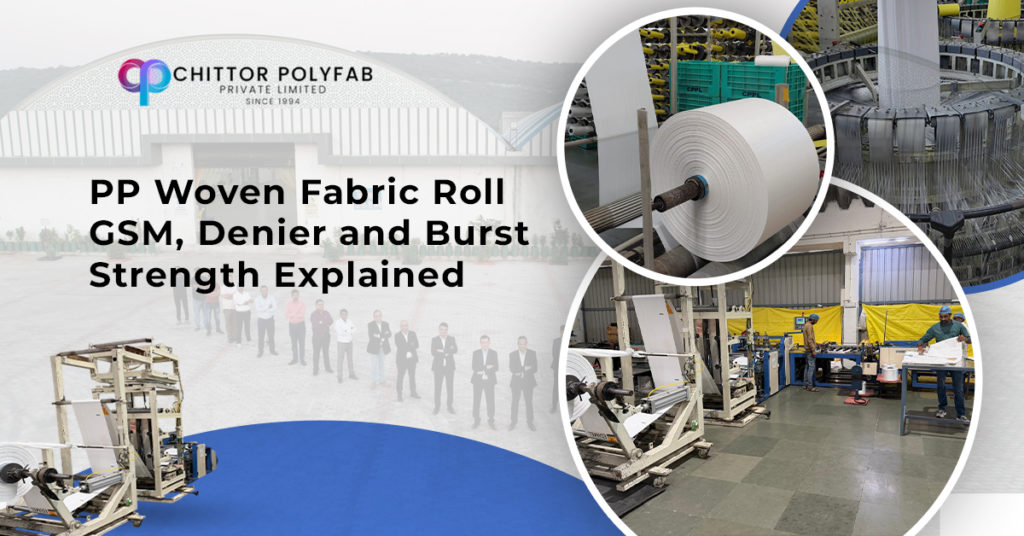A PP woven fabric roll is made from interlaced polypropylene tapes woven tightly in both directions to create a strong, durable material used across industries. Its versatility, cost efficiency, and resistance to tearing or moisture make it the preferred choice for packaging, agriculture, and construction applications. The strength and performance of each roll depend on measurable factors such as GSM, denier, and burst strength that together determine how well the fabric performs under stress
GSM (Grams per Square Meter): Fabric Weight That Matters
GSM defines the weight of the woven fabric per square meter and directly affects its thickness and load-bearing strength. A consistent GSM ensures stable fabric performance during manufacturing, printing, and use
- 50–90 GSM: Lightweight rolls used for grain covers, small packaging, and inner liners
- 100–140 GSM: Standard for bulk packing of fertilizer, rice, and sugar bags
- 150–200 GSM: Ideal for heavy-duty sacks, tarpaulins, and construction-grade fabric
- 200+ GSM: Best suited for geotextiles, industrial wrapping, and multi-layer laminated rolls
At Chittor Polyfab, precision extrusion and weaving machines maintain GSM uniformity within tight tolerance limits so that every PP woven fabric roll meets customer specifications without variation
Denier: Measuring the Thread Strength of Polypropylene
Denier is the measure of the thickness of each filament that forms the fabric. It defines the roll’s durability, flexibility, and resistance to abrasion
- 500–800 Denier: Offers flexibility for lightweight packaging
- 900–1200 Denier: Balanced for standard woven sacks and industrial wraps
- 1300–2000 Denier: Provides maximum durability for export-grade applications
Higher denier fabric rolls deliver more tensile strength but may reduce softness and print clarity, so the right denier must align with the end-use requirement. For outdoor or heavy-load applications, higher denier ensures stability under extreme pressure
Burst Strength: Indicator of Pressure Resistance
Burst strength shows how much pressure the fabric can handle before breaking. This parameter combines the effects of GSM, denier, and weave structure. A roll with high burst strength can resist internal stress during stacking, filling, and transportation
Testing is done using a hydraulic burst tester that applies pressure uniformly on a sample until it ruptures. Most high-quality PP woven fabric rolls record burst strengths between 20–40 kg/cm² depending on the lamination and coating used. This ensures that the rolls can hold weight without losing form or tearing during use
Tensile Strength and Elongation Ratio
Tensile strength determines how much pull the fabric can withstand before breaking. For standard PP woven fabric rolls, ideal tensile strength lies between 250–600 N/5cm, depending on the weave and denier. Elongation percentage reflects flexibility, fabric that stretches slightly without losing shape is more durable and resistant to damage during handling
Weave Density and Fabric Uniformity
The density of tapesper inch affects both the roll’s flexibility and strength. A 8×8 ,10×10 or 12×12 weave (mesh) ensures proper balance, preventing loose texture or tight stiffness. Uniform weave density gives smooth surfaces for lamination, better print quality, and minimal wastage during cutting. Maintaining correct warp and weft tension throughout the weaving process guarantees fabric uniformity across large rolls
Lamination, Coating, and UV Protection
For added protection, PP woven fabric rolls are often laminated or coated. Lamination helps create moisture-proof and dust-resistant surfaces, making them ideal for fertilizers, grains, and industrial goods. Rolls with UV-stabilized coating can resist sunlight degradation, extending their life in outdoor applications such as tarpaulins, truck covers, and construction sheets
Depending on customer requirements, Chittor Polyfab provides customized rolls laminated, non-laminated, UV-treated, or perforated for specific industrial uses while maintaining consistent physical properties
Common Testing Methods for PP Woven Fabric Roll
Reliable performance depends on precise testing. Some standard tests include
- GSM Testing: To measure weight consistency
- Tensile Test: To evaluate breaking strength
- Burst Test: To measure pressure tolerance
- Tear Resistance Test: To check edge durability
- UV Exposure Test: To ensure weather stability
Following ISO 21898:2004 and ASTM D3786 standards ensures quality across global applications, from packaging to geotextile usage
Applications of PP Woven Fabric Rolls Across Industries
A PP woven fabric roll is highly versatile and used in many sectors for safe, cost-effective packaging solutions
- Agriculture: Fertilizer, seed, and feed packaging
- Construction: Cement, sand, and gravel sacks
- Food & Beverage: Sugar, flour, and rice storage bags
- Industrial Use: Pallet covers, wrapping fabric, and liners
- Geotextile: Soil stabilization and erosion prevention
These rolls are valued for their ability to resist moisture, retain shape, and endure rough handling, making them indispensable in heavy-duty environments
Factors to Consider Before Purchasing
When selecting the right PP woven fabric roll, ensure these key quality points are met
- Uniform GSM and denier across batches
- Verified burst and tensile strength reports
- Even weave texture and consistent shade
- Proper lamination or UV protection for required use
- Compliance with international quality testing standards
A transparent manufacturing process and certified testing guarantee that the roll performs efficiently throughout its service life
Why Industries Prefer Chittor Polyfab
Chittor Polyfab’s advanced weaving technology, consistent quality checks, and precision calibration make it a trusted partner for industries seeking premium PP woven fabric rolls. The company’s in-house testing facilities, UV stabilization systems, and customized GSM denier combinations ensure that every roll meets both performance and aesthetic expectations. With a strong focus on research and durability, Chittor Polyfab continues to deliver woven fabric solutions that add value and reliability to packaging and industrial applications
